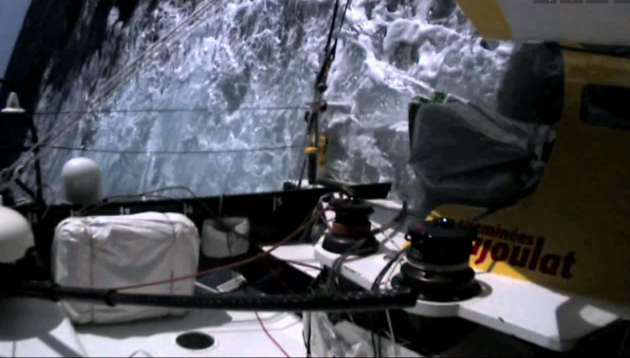This video of solo sailor Bernard Stamm, laid flat after an accidental gybe during the Vendée Globe , shows what he did next
This video of a yacht laid flat after an accidental gybe is an interesting snapshot of a day in the life of the hardships of a solo ocean racer. And what follows is that sailor’s explanation of the sequence of events.
It was shot by Bernard Stamm on day two of the 2013/4Vendée Globe while off the Portugal coast, but has only just emerged from the boat now he has finished. It’s interesting because it shows the hard nature of solo racing in its everyday hue: the routine diet of things going wrong and the wavetrain succession of incidents with the potential to escalate into major breakages.
And, by the way, in case you didn’t know or had forgotten, this was just the very start of what has probably been Stamm’s hardest ever Vendée Globe – he was forced out of two previous editions, and lost his boat on the rocks in 2008.
To recap, he was disqualified from the race after mooring to a ship at Auckland Island, south of New Zealand, where he’d gone to try to fix his hydrogenerators.
Banished from the Vendée Globe but carrying on desperately short of fuel, Stamm had no choice but to handsteer across the South Pacific, sitting out in the cold for 21 hours a day. He navigated with a portable GPS and paper charts.
He had to sail as fast as possible. The sooner he could reach Cape Horn the better he could eke out his last reserves of diesel to operate the autopilot 2-3 hours a day so as to sleep. He had just enough juice left to fire up his electronic chartplotter to help with the Cape Horn landfall.
But back to this video of the more everyday hassles. Bernard explained to me what was going on, and I’ve annotated the running minutes so you can get the gist of the action.
Quand les ennuis commençaient à bord de… by VendeeGlobeTV
1:00
Bernard is running downwind at 25 knots boatspeed under main and small spinnaker. There is a problem with his starboard hydrogenerator and he starts the cockpit video recorder to show him going over the back of the boat to disconnect it.

1:18
At this moment, the autopilot unexpectedly switches off and the boat accidentally gybes, putting the spinnaker on the wrong side, pinning the boom against the runner and the boat lays flat in the water and stops. “Lucky I didn’t break anything,” says Bernard. “That was a miracle.”

1:46
He goes to release the runner, but remembers that he has used the runner tail temporarily to lash on the hydrogenerator he’d been working on, so he has to climb up to untie it first. Meanwhile, you can hear the autopilot off-course alarm going off.

3:18
Bernard manages to ease the backstay. The sail stacked outboard is his genoa, which was fastened on, but not very tightly. The boat begins to move and you see Bernard steering, while also trying to operate the canting keel, which is on the wrong side. You hear the motor for that beginning at 4:05 and gradually the boat begins to come upright and tear off again downwind.

05:56
Another brief accidental gybe. This happened “three or four times” that afternoon.

07:05
Bernard says he’s wondering here what’s going on. “It was about an hour before I could stabilise the pilot enough to find a way to get it to steer while I got on the phone to the shore team to tell them we had a real problem we needed to sort out or I would not get past Portugal,” he explains.

His autopilot problems persisted all the way round the world. “We solved a lot of problems, but we never got the real one. There must have been a bug,” he says.
An average days’ work for this single-hander then.




